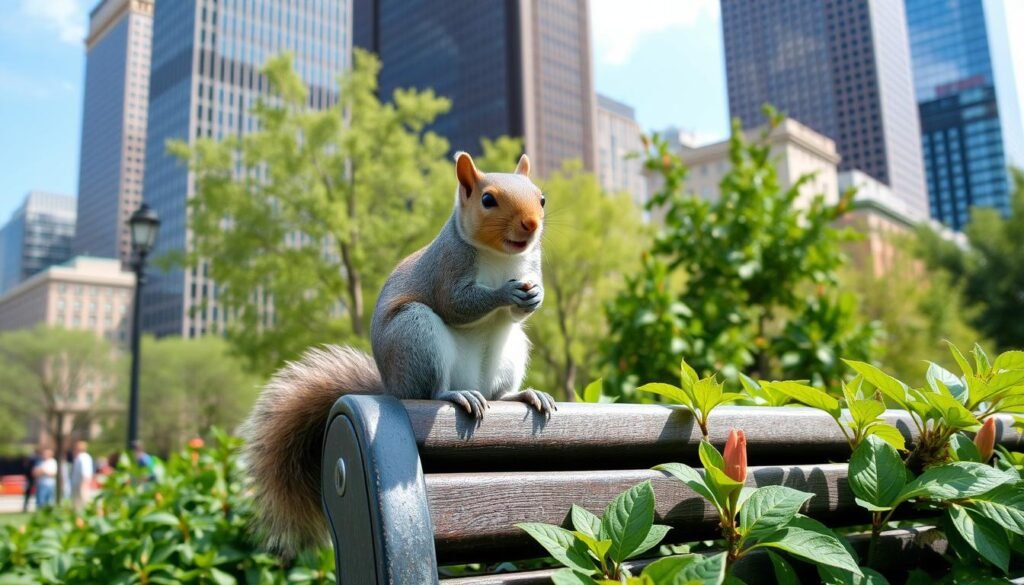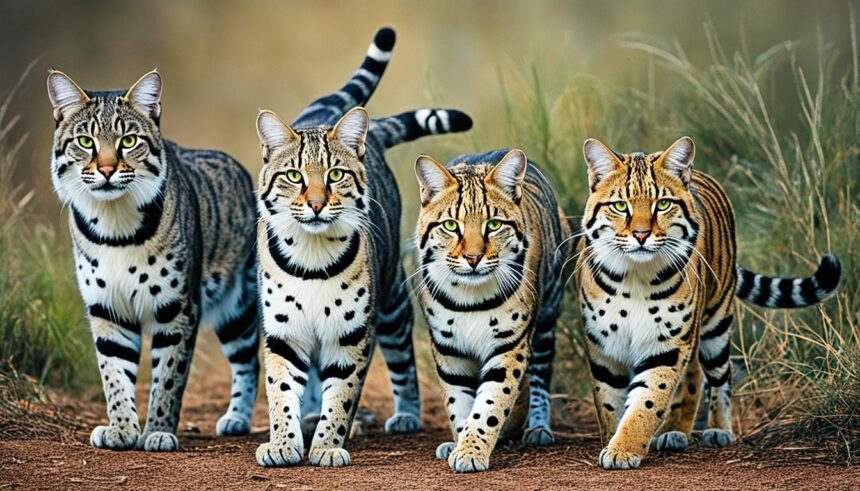The eastern gray squirrel is a common sight in North America. This rodent, known for its bushy tail, lives in forests and urban parks. It belongs to the Sciuridae family, which includes over 200 squirrel species worldwide.
These adaptable creatures fascinate both wildlife fans and casual observers. Their engaging personalities make them iconic in many areas.
Eastern gray squirrels are native to the eastern U.S. and southern Canada. Their range extends to the Midwestern grasslands. They’ve also been introduced to other countries, where they’ve established thriving populations.
Introduction to the Eastern Gray Squirrel
The eastern gray squirrel is native to the eastern U.S. and parts of Canada. These clever rodents have adapted well to urban and suburban areas. You’ll often spot them in parks, backyards, and city streets.
Many people love these charming creatures. However, they’re also known as an invasive species in some parts of the world. In Europe, they’ve settled in countries like the UK and Italy.
These squirrels thrive in various environments. They’re at home in dense forests and city parks alike. Their adaptability has led to their widespread distribution.
Eastern gray squirrels have unique physical traits and interesting behaviors. They play a role in urban ecosystems but face challenges as an invasive species. Let’s explore what makes these squirrels so fascinating.
Physical Characteristics of the Eastern Gray Squirrel
The Eastern gray squirrel is a medium-sized rodent with a distinctive look. It’s one of the most common squirrel species in North America. Let’s explore the physical traits that make them unique.
Size and Weight
Adult Eastern gray squirrels are 16 to 20 inches long, including their bushy tail. Their tail makes up almost half of their total length. These squirrels usually weigh about one pound.
Some can reach 1.5 pounds, depending on age, sex, and food supply.
Fur Color and Variations
Eastern gray squirrels have fur that’s a mix of gray, brown, black, and white hairs. From far away, they look mostly gray. But color variations exist within the species.
Some squirrels may have black, white, or even blond fur. These color changes depend on genetics and where they live.
Distinctive Features
The Eastern gray squirrel’s large, bushy tail is its most notable feature. It’s flat and covered in long, silvery-tipped hairs. The tail serves many purposes.
It acts as a rudder when jumping and helps with balance in trees. Squirrels use it as a blanket in cold weather. They also flick their tails to show aggression or alarm.
These squirrels have prominent, slightly tufted ears and sharp claws for climbing. They also have excellent vision to find food and navigate their surroundings.
| Physical Characteristic | Description |
|---|---|
| Body length | 16-20 inches (including tail) |
| Weight | 1-1.5 pounds |
| Fur color | Mixture of gray, brown, black, and white; color morphs include black, white, and blond |
| Tail | Bushy, flattened, with silvery-tipped hairs; serves multiple purposes (balance, communication, warmth) |
| Ears | Prominent, slightly tufted |
| Claws | Sharp, aid in climbing and foraging |
Habitat and Range
The eastern gray squirrel thrives in diverse habitats across North America and worldwide. Its success stems from adaptability to various food sources and environments.
This rodent adjusts well to different conditions. It plays a key role in forest regeneration as a seed disperser.
Native Range in North America
The eastern gray squirrel’s native range covers the eastern United States. It extends from the Atlantic coast to the Mississippi River.
The species inhabits areas from southern Canada to the Gulf of Mexico. It’s abundant in hardwood forests of the eastern and midwestern United States.
Introduced Populations Worldwide
The eastern gray squirrel has spread beyond its native range. It now thrives in parts of western North America, Europe, South Africa, and Australia.
In some European areas, it has outcompeted native squirrel species. The Eurasian red squirrel has been displaced in certain regions.
| Region | Countries with Introduced Populations |
|---|---|
| North America | Western United States, Canada |
| Europe | Ireland, Britain, Italy |
| Africa | South Africa |
| Australia | Australia |
Preferred Habitat Types
The eastern gray squirrel adapts to various habitats. It lives in mature hardwood forests, mixed forests, and urban areas.
These squirrels thrive in parks, suburbs, and even farmlands. They can use human-provided food sources like bird feeders.
Key habitat needs include food sources and nesting sites. They use tree cavities, leaf nests, and sometimes building spaces.
Diet and Feeding Habits

Eastern gray squirrels are adaptable eaters with a diverse diet. They eat plants, seeds, nuts, berries, and sometimes insects. Their flexible eating habits help them thrive in natural and urban areas.
These rodents can survive on various food sources. This ability has made them successful in different environments.
Common Food Sources
Gray squirrels mainly eat hard mast like acorns, hickory nuts, and walnuts. They also enjoy seeds, berries, fruits, flowers, buds, and shoots.
In late summer, they feast on wild cherries and dogwood berries. When food is scarce, they may eat fungi, insects, and bird eggs.
Seasonal Dietary Changes
Eastern gray squirrels’ diet changes with the seasons. In autumn, they eat and store high-energy foods for winter.
During winter, they become less active and rely on stored food. They dig up buried acorns and nuts from the ground.
Spring and summer bring a wider variety of plant foods. Squirrels eat buds, flowers, and fruits during these seasons.
| Season | Primary Food Sources |
|---|---|
| Spring | Buds, flowers, seeds, fungi |
| Summer | Fruits, berries, seeds, insects, bird eggs |
| Autumn | Nuts, acorns, seeds, cones |
| Winter | Cached nuts and seeds, bark, buds |
Caching Behavior
Eastern gray squirrels are known for storing food in small caches. They bury nuts, seeds, and acorns in shallow holes throughout their area.
This behavior helps them survive when food is scarce. It also plays a key role in spreading seeds for various trees.
Gray squirrels have an amazing memory for finding their hidden food. Sometimes, they don’t find all their caches, which leads to new tree growth.
Reproductive Biology
Eastern gray squirrels have two mating seasons yearly. The first is from December to February, and the second from May to June. Males mate with multiple females to boost their reproductive success.
These squirrels use a polygamous mating system. This approach helps maintain their population and ecological success.
Mating Season and Behavior
Male squirrels mature sexually at 9-11 months. Females mature earlier, at about 6-8 months. During mating season, males chase females and make noises.
They do this to show dominance and attract mates. Once paired, they mate several times over a few days.
Gestation Period and Litter Size
Female squirrels are pregnant for 40-45 days. They give birth to 2-6 young, with an average of 3-4 per litter.
Studies on Umbrian grey squirrels show interesting results. 69% of females have one or two litters yearly. 31% don’t reproduce at all.
Parental Care and Development of Young
Newborn squirrels are hairless, blind, and rely on their mother. The mother nurses them in a tree cavity or leaf nest.
At 3-4 weeks, the kits open their eyes and grow fur. By 6-8 weeks, they explore and try solid foods.
Young squirrels are weaned at 10-12 weeks. They soon leave the nest to find their own territories.
| Reproductive Stage | Age/Duration |
|---|---|
| Male sexual maturity | 9-11 months |
| Female sexual maturity | 6-8 months |
| Gestation period | 40-45 days |
| Litter size | 2-6 young (average 3-4) |
| Eyes open and fur growth | 3-4 weeks |
| Weaning age | 10-12 weeks |
Eastern gray squirrels are adaptable and resilient. They have multiple litters yearly and provide good maternal care. This ensures their populations thrive in various habitats.
Eastern Gray Squirrel Behavior

Eastern Gray Squirrels are fascinating creatures that thrive in various environments. These diurnal animals are most active during the day. They engage in foraging, socializing, and building nests.
Activity Patterns and Daily Routines
Eastern Gray Squirrels follow a consistent daily routine. They start by foraging for food like nuts, seeds, and fruits. When preferred foods are scarce, they may eat insects or bird eggs.
Throughout the day, they take breaks to rest and groom. They also engage in social interactions with other squirrels.
Communication and Social Interactions
These rodents communicate through various vocalizations, including barks, buzzes, and squeals. Each sound conveys a specific message, like alerting others to threats. Eastern Gray Squirrels are social animals and may share nests called dreys.
A study in Williamstown, Massachusetts, observed 500 social interactions among 34 marked gray squirrels. Most interactions were non-aggressive, such as feeding, resting, and social grooming. Aggressive behavior occurred mainly between resident squirrels and transients.
Adaptations to Urban Environments
Eastern Gray Squirrels adapt well to urban environments. They’re common in parks, neighborhoods, and other human-dominated landscapes. Their success stems from intelligence, adaptability, and opportunistic feeding habits.
In urban areas, squirrels often rely on food from humans. This includes bird feeders and food waste.
A study by Engel et al. (2020) explored squirrel abundance in various urban habitats. Parks had the most squirrels, followed by urban forests, neighborhoods, cemeteries, and golf courses.
| Habitat Type | Relative Abundance |
|---|---|
| Parks | Highest |
| Urban Forests | High |
| Neighborhoods | Intermediate |
| Cemeteries | Low |
| Golf Courses | Lowest |
The study also examined flight initiation distance (FID) in different habitats. FID is how close a human can get before a squirrel flees. Park squirrels had greater FID than neighborhood squirrels.
This suggests that urban wildlife behavior is influenced by surroundings. The level of human activity in an area also plays a role.
Ecological Role and Importance
Eastern gray squirrels are vital for seed dispersal and forest growth. They bury lots of seeds, which can grow into new trees. This helps forests expand and become more diverse.
These rodents also plant trees without meaning to. When they forget about buried seeds, those seeds can sprout. This natural process helps forests thrive and grow.
Gray squirrels are an important food source for many animals. Hawks, owls, and foxes rely on them for survival. This makes squirrels a key part of the food web.
A healthy squirrel population helps keep the ecosystem balanced. They support predator species and contribute to overall environmental health. Their presence is crucial for maintaining nature’s delicate balance.
Squirrels shape landscapes beyond their immediate homes. They help forests grow and change the mix of tree species. This creates homes for many other animals and plants.
In places like Florida, squirrels are vital to native ecosystems. They play a big role in keeping long-leaf pine forests healthy. Their actions have far-reaching effects on the environment.
| Ecological Role | Importance |
|---|---|
| Seed dispersal | Inadvertently planting trees and promoting forest regeneration |
| Prey species | Supporting the survival of predators like hawks, owls, and foxes |
| Ecosystem maintenance | Expanding forests, influencing tree species composition, and creating habitats for other organisms |
Eastern gray squirrels show how species are connected in nature. They spread seeds and serve as prey for other animals. These furry creatures help keep ecosystems healthy and stable for years to come.
Interactions with Humans

Eastern gray squirrels thrive in urban and suburban areas. They’re common in parks, backyard habitats, and college campuses. Many enjoy their playful antics, but some view them as pests.
Squirrels as Pests
Eastern gray squirrels can frustrate homeowners in urban environments. They raid bird feeders and consume large quantities of seed. These clever animals dig up newly planted bulbs and create unwanted “squirrel gardens” in lawns.
Squirrels may enter attics or wall spaces, damaging insulation and wiring. Their gnawing habits can pose a fire hazard if they chew through electrical wires.
Squirrels as Popular Park Residents
Despite conflicts, eastern gray squirrels are beloved park residents. They entertain visitors with their scampering and playful chases. Many people enjoy feeding squirrels in parks, offering nuts and seeds.
This practice can make squirrels bolder. However, it also allows for close-up observation and fosters a connection with wildlife.
| Squirrel Group | Average Flight Initiation Distance (FID) | Standard Deviation |
|---|---|---|
| Urban Squirrels | 16.2 meters | 4.9 meters |
| Rural Squirrels | 8.8 meters | 6.6 meters |
Studies show urban squirrels are bolder than rural ones. The table above shows urban squirrels tolerate closer human approaches before fleeing. This indicates they’re more comfortable around people.
Hunting and Management
Some areas manage eastern gray squirrel populations through regulated hunting seasons. Hunting helps control numbers where squirrels have few natural predators. It’s a popular pastime in many parts of the United States.
Other strategies minimize conflicts between squirrels and humans. These include squirrel-proof bird feeders and exclusion techniques. Some areas use humane relocation programs.
Understanding squirrel ecology and behavior helps humans coexist with these adaptable creatures. Implementing appropriate management strategies when needed ensures a harmonious environment for all.
Conservation Status and Threats
The eastern gray squirrel is classified as “least concern” by the IUCN. It’s considered secure by NatureServe. This is due to its widespread distribution and adaptability across its native range.
The squirrel thrives in the eastern and midwestern United States. It’s also found in parts of Canada, East Texas, and Florida.
In regions where it’s been introduced, the eastern gray squirrel is often invasive. These areas include western states and Vancouver Island. It’s also invasive in Ireland, Britain, Italy, South Africa, and Australia.
In Europe, it’s listed as an Invasive Alien Species of Union concern. This listing prohibits its importation, breeding, and release within the European Union.
The introduction of eastern gray squirrels has led to competition with native species. This is especially true for the Eurasian red squirrel. Studies show gray squirrels replacing red ones in Italy and Ireland.
| Region | Native or Introduced | Conservation Status |
|---|---|---|
| Eastern and Midwestern United States, parts of Canada | Native | Least Concern (IUCN), Secure (NatureServe) |
| Western United States, Vancouver Island (Canada), Ireland, Britain, Italy, South Africa, Australia | Introduced | Invasive, listed as Invasive Alien Species of Union concern in Europe |
In their native range, eastern gray squirrels face threats from habitat loss. Their population decreased in the midwestern United States due to human actions. By 1900, they were almost absent in Illinois.
Eastern gray squirrels prefer mature woodlands over 40 hectares. These areas need diverse understory vegetation. Loss of such habitats can impact their populations.
Disease also affects eastern gray squirrels and their interactions with other species. Poxviral disease in red squirrels correlates with their population decline in the UK. In Italy, introduced gray squirrels lack squirrelpox virus.
Eastern gray squirrels can spread diseases like typhus, plague, and tularemia. They also carry parasites such as ringworm, fleas, and ticks. These can harm both squirrels and humans.
Interesting Facts About Eastern Gray Squirrels

Eastern gray squirrels are fascinating creatures with unique traits. They have impressive spatial memory, varied vocalizations, and play a crucial role in forest regeneration. These rodents showcase adaptability and ecological importance.
Impressive Spatial Memory
Eastern gray squirrels have exceptional spatial memory. They can find food caches buried under snow using their keen sense of smell. This ability helps them survive harsh winters when food is scarce.
These clever rodents also engage in “deceptive caching”. They pretend to bury nuts to trick potential thieves. This behavior shows their intelligence in protecting food sources.
Varied Vocalizations
Eastern gray squirrels use various sounds to communicate. They express different emotions and share information with other squirrels. Their calls serve many purposes in their social interactions.
- Alarm calls to warn others of potential threats
- Aggressive chatters during territorial disputes
- Soft, contented purrs while resting or grooming
- Mating calls to attract potential partners
These diverse vocalizations highlight the complex social structure of eastern gray squirrels. They use sounds to convey important information and maintain their community.
Role in Seed Dispersal
Eastern gray squirrels are vital for forest regeneration. They bury nuts and seeds for future meals, unintentionally planting new trees. This caching behavior contributes to the health of their habitats.
Squirrels may lose up to 25 percent of their buried food. They forget some cache locations or lose them to thieves. This leads to unplanned seed dispersal throughout the forest.
| Squirrel Behavior | Ecological Impact |
|---|---|
| Caching nuts and seeds | Unintentional planting of new trees |
| Forgetting cache locations | Seed dispersal and forest regeneration |
| Losing cached food to thieves | Increased seed distribution |
Eastern gray squirrels are natural seed dispersers. They help maintain biodiversity in their forest ecosystems. This makes them essential to the ecological web of their habitats.
Conclusion
Eastern gray squirrels are adaptable rodents native to North America. They thrive in various habitats and have spread through human introductions. Their gray fur and playful antics make them popular in parks and gardens.
These squirrels play a vital role in ecosystems as seed dispersers. They also serve as prey for many predators. However, their introduction to new areas can cause conflicts with native species.
Understanding eastern gray squirrels helps us appreciate their significance. Their acrobatic skills and problem-solving abilities are impressive. These creatures remind us of the diverse wildlife around us.
FAQ
What is the scientific name of the eastern gray squirrel?
Sciurus carolinensis is the scientific name for the eastern gray squirrel.
How big are eastern gray squirrels?
Adult eastern gray squirrels are 16-20 inches long, including their bushy tail. They can weigh up to 1.5 pounds.
What is the native range of the eastern gray squirrel?
Eastern gray squirrels are native to the eastern and midwestern United States. They also live in southern parts of Canada.
What do eastern gray squirrels eat?
Eastern gray squirrels eat a mix of seeds, nuts, berries, and buds. They sometimes munch on insects, bird eggs, and baby birds.
Their favorite foods include acorns, hickory nuts, walnuts, and beechnuts. These change with the seasons.
How often do eastern gray squirrels have litters?
Eastern gray squirrels mate twice a year. This happens from December to February and May to June.
Females give birth to 2-6 babies after 40-45 days. This is called the gestation period.
Are eastern gray squirrels active during the day or night?
Gray squirrels are diurnal. This means they are most active during daylight hours.
How do eastern gray squirrels contribute to the ecosystem?
Eastern gray squirrels are scatter-hoarders. They play a key role in spreading seeds and helping forests grow.
They bury food and sometimes forget about it. This leads to new trees growing by accident.
Are eastern gray squirrels considered pests?
Many people enjoy watching eastern gray squirrels in parks and yards. However, they can be pests too.
They might raid bird feeders, dig up gardens, or sneak into attics. This can be annoying for some people.
What is the conservation status of the eastern gray squirrel?
The IUCN lists eastern gray squirrels as a species of “Least Concern”. This is because they live in many places.
However, in parts of Europe where they were brought in, they’re seen as invasive. This means they can harm local ecosystems.
What is a unique fact about eastern gray squirrels?
Eastern gray squirrels have amazing spatial memory. They can find food they’ve hidden, even under a foot of snow.













